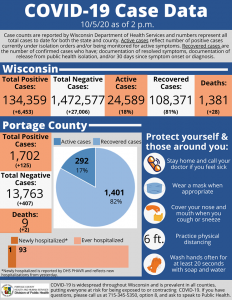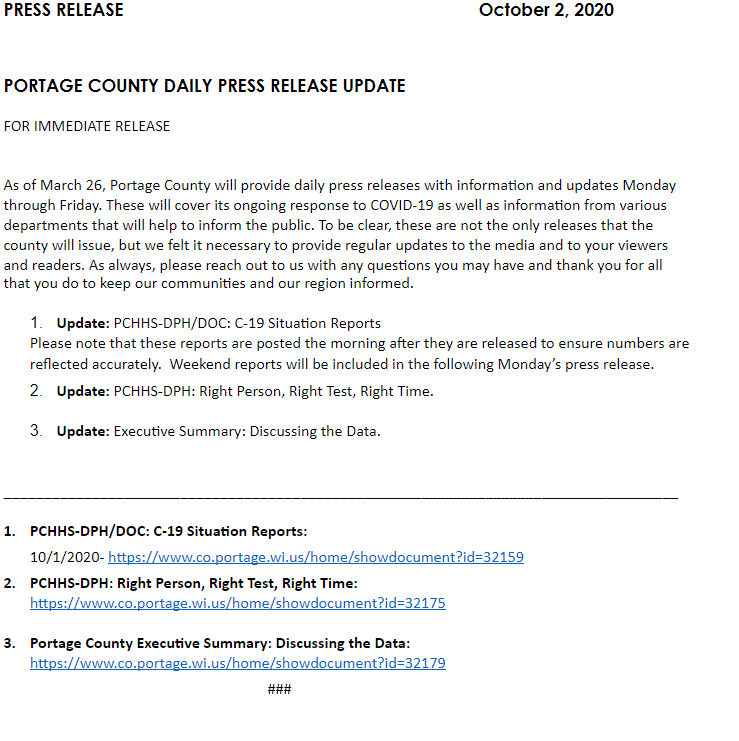Editorial: Dear Portage County, just the facts on COVID, please
By Brandi Makuski
This editorial isn’t about COVID-19.
This is an open letter to Portage Co. government regarding its style of communication, lackluster press releases, and generic, manufactured statements about its response to the pandemic itself.
At press, Portage Co. has lost nine of its residents to the coronavirus. Despite repeated requests for additional information, the county health department has declined to provide details sought by the public and press alike: whether those victims had any underlying health issues; and some idea of their location inside the county.
The latest request seeking this information, which the Metro Wire sent to Portage Co. Health Officer Gary Garske on Sept. 29, earned this reply on Sept. 30: “I have raised your question up to our PIO Group for response.” One week later, this question remains unanswered.
In his response to an Oct. 5 email seeking information on the number of COVID beds, and hospital capacity, in Portage Co. Garske said, “Sending your question to the NCW HERC for response.”

I suppose we’re fortunate that Portage Co. has such an organized social media presence to dazzle the public and distract the press…those fun little infographics someone in county government is charged with creating has managed to, for some, reduce the pandemic to a chart with data about current infections, deaths, and testing rates.
Any actual context beyond the numbers is delivered to the press three hours later—after the public has consumed the information via Facebook, made their own assumptions, and posted links in the comment thread from every conceivable conspiracy website they can find; and after anyone from the county in a position to comment on the daily information has gone home.
The daily press releases received by newsrooms contains not summarized updates and bullet points of new information, but rather links to pages of convoluted information, overly-wordy columns from the county executive, and rambling “news releases” that bury the most important information:
In its practice, the county has created an environment where misinformation can—and does—thrive.
While Portage Co. has lost a lot of institutional knowledge due to high turnover in recent years, this isn’t the first pandemic in Portage Co. H1N1, commonly known as swine flu, hit in 2009, which infected over 60 million people and killed as many as 575,000 people worldwide in its first year, according to the CDC. Some of you reading this may remember the swine flu vaccination clinic offered at the former Holiday Inn Holidome in North Stevens Point.
In Wisconsin, 9,579 cases of the swine flu resulted in 1,317 hospitalizations and 55 deaths. It’s far lower than the current numbers related to COVID-19, but the numbers are irrelevant: emergency procedures and policies are a template, designed to be applicable across the board. Members of Portage Co. Emergency Management train throughout the year to handle large-scale emergencies and—supposedly—communicate with the press.
Unfortunately, much of the information needed to put together some solid reporting on COVID—as opposed to publishing what boils down to a status update—isn’t made available to the press because county officials like to hide behind HIPAA.
The Health Insurance Portability and Accountability Act is a federal law enacted in 1996 that required the U.S. Department of Health and Human Services to establish federal health privacy regulations. Commonly known as the “Privacy Rule,” the regulations are intended “to assure that individuals’ health information is properly protected while allowing the flow of health information needed to provide and promote high-quality health care and to protect the public’s health and well being.”
Portage Co. holds weekly conference calls with various department heads, municipal leaders, police/fire/EMS officials, and representatives from local hospitals and health care centers to share the most up-to-date information related to the number of cases, strains on facilities, the supply and demands of PPE, and other pandemic-related issues inside Portage Co.
The press has been kept out of this weekly call, despite repeated requests from the Metro Wire to Portage Co. Executive Chris Holman, Sheriff Mike Lukas, and the county health department, because, they argue, it could violate HIPAA. But early in the pandemic, the county did attempt to satisfy the press by holding semi-regular press conferences via Webex. Questions were requested in advance but, if there was time, could also be asked live.
The problem with the briefings was the lack of specific information provided for journalists. Questions were given generic answers, often with a heavy dose of the standard, “We’re doing the best we can with what we’ve got.”
Eventually, the number of reporters attending the briefings dwindled down to one before the county stopped holding them: you’re reading her editorial right now.
But is HIPAA being evoked too often and inappropriately? We believe it is being used as a shield to avoid providing more details—perhaps due to a lack of staffing, a desire to avoid public panic, or a lack of awareness or care as to what news reporters really need to answer their readers’ questions.
Despite having more staff working in emergency management than ever before, Portage Co. doesn’t employ a Public Information Officer experienced in working with the press. No one to rework those wordy submissions from department heads before they’re sent out. No one to ensure the message isn’t getting lost on its way to weary newsrooms, and to citizens overwhelmed by COVID information via social media.
Information is simply plugged into a press release template then sent to the media, sans complete information, and at the end of the business day.
It’s no wonder our infection rates are skyrocketing. The county’s communication has become white noise for an overworked press corps, and a populace who can only agree on one thing—they’re sick and tired of hearing about COVID.


